What Animals Have Been Endangered But Have Recovered In New York

How NYC Parks Protects Rare and At-Hazard Wildlife
New York Urban center is home to a wide array of rare and unusual animal species that nigh people rarely see or know well-nigh — including herring, terrapin, pipage plovers, and bald eagles. These animals depend on the health of parks, from our wildest forests to our expansive shorelines, to survive and thrive.
We have successfully worked with community partners and volunteers in parks throughout the city to restore creature populations that were once at risk. These include alewife river herring in the Bronx River, diamondback terrapins in Jamaica Bay, and piping plovers on Rockaway Beach—all of which have become a more common sight in NYC in recent years.
Take a wait at some of the rare and at-chance animals NYC Parks cares for:
Atlantic Declension Leopard Frogs
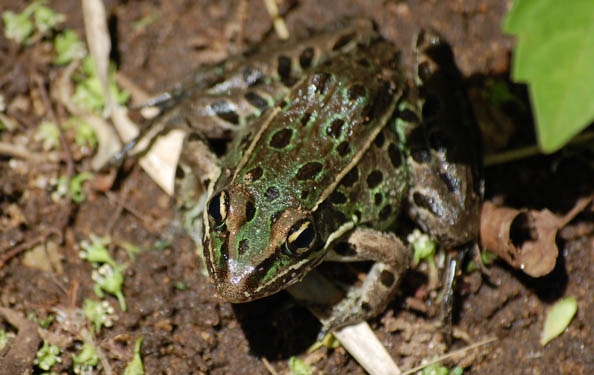
Found in expansive open-canopied wetlands, this frog tin be identified by its distinct dorsal spots and unique "chuck"-similar call that can exist heard during the breeding period (tardily March to early on April).
Threat
Once widespread and amongst the most common frog species in the NYC region, it's at present found in only a handful of sites in NYC—all on Staten Island. Substantial evidence of population decline points to a combination of disease and habitat loss.
What we're doing to assist
We will assistance ensure the long-term survival of the Atlantic Coast Leopard Frog on Staten Island through monitoring and managing its natural resources, and protecting sensitive areas equally Forever Wild habitat.
American Eels
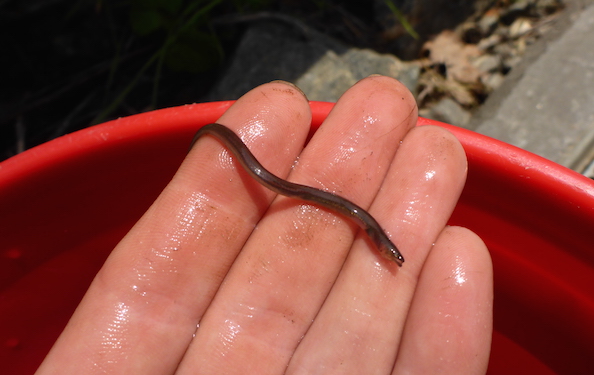
American Eels are born thousands of miles away in the Sargasso Ocean in the North Atlantic Ocean. They disperse forth the Atlantic Declension and travel upstream to freshwater. They live in streams and rivers for the adjacent 20 or 30 years of their lifespan. Once they achieve sexual maturity, they make the long journey back to where they hatched, where they spawn simply once then die. They are considered "catadromous fish" because they spend most of their life in freshwater and only require saltwater for part of their life bike.
Threat
Due to overfishing and habitat loss, particularly acquired past barriers like dams that prevent the eels from reaching freshwater habitat, American Eel populations are dramatically reduced.
What we're doing to assist
In partnership with the Bronx River Brotherhood and other partners, we're working to restore American Eel populations in the Bronx River by creating access to freshwater habitat. An eel ladder was installed at the first dam barrier in the River in 2015 to aid American Eels get over the dam and admission the habitat they demand. Since it's opening, the fish ladder has allowed more than than 1,300 American eels to swim over the dam. We're working to design and build boosted eel ladders at the other upstream barriers, or to remove the barriers where possible so that American Eels can access the residue of the Bronx River once again.
Bald Eagles
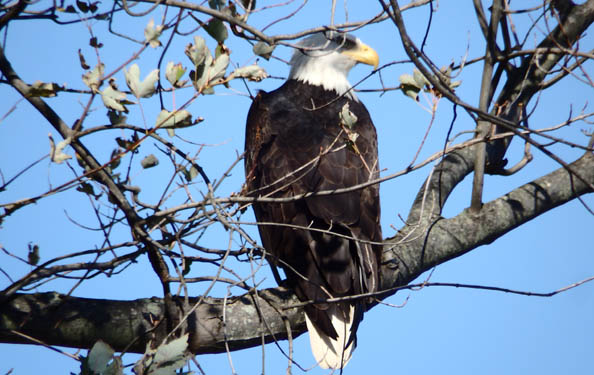
Bald eagles—our land's national bird—volition usually nest shut to h2o sources for easy access to fish, which is their primary food source along with carrion. Nests are often found high in copse. Bald eagles sometimes mate for life, and breed at iv-5 years old, typically laying between one and three eggs.
Threats
Though baldheaded eagles have made a comeback in recent years thanks in big role to the banning of the harmful pesticide Ddt, high temperatures and habitat loss caused by climate change are notwithstanding a threat to their survival.
What nosotros are doing to help
NYC Parks' Wildlife Unit of measurement monitors active raptor nests--including those of bald eagles--on a yearly basis throughout the metropolis to improve understand their nesting preferences and inform rodenticide usage. Baldheaded eagles have been recently spotted in parks along the Hudson River, including Inwood Colina Park and Riverside Park.
Diamondback Terrapins

These turtles can be found all along the unabridged east coast shoreline, every bit far s as the Florida Keys and around into the Gulf Coast of Texas. They inhabit the brackish water of marshes and shallow bays. During the warmer months (Apr-October), they are actively feeding and reproducing. In the wintertime, they nestle into the mudflats of their dwelling house range and get into torpor, a state of decreased physiologic action, to conserve energy.
Threats
Historically a favorite food source, terrapin numbers plummeted between the late 1800s-early 1900s due to unregulated over-harvesting for turtle soup. Current threats are all man-associated. Population numbers are decreasing due to habitat loss caused past the development of roads and buildings along waterways. Predation rates of eggs and hatchlings by animal species that benefit from human-altered environments (raccoons, foxes, and rats) are extremely high. Many terrapins dice due to beingness hit past cars during route crossings and as by-catch in crab pots.
What we are doing to assistance
For the past few years, nosotros have been studying Diamondback Terrapins in the salt marshes of Queens to attempt to appraise the numbers in and around NYC Parks and understand how these small populations may collaborate with those being studied virtually John F. Kennedy airdrome and in Jamaica Bay. We have surveyed nest numbers and locations, calculated predation rates, and protected incubating nests past incorporating exclosures in Idlewild Park. During this time, we take engaged interns from diverse universities and students from local later on-school programs.
Currently, we are studying terrapins in marshes forth ii roadways in William T. Davis Wildlife Refuge (Staten Isle) and Idlewild Park (Queens) to empathize how road infrastructure impacts terrapin movement and livelihood. By conducting population surveys before and after road-raising construction, nosotros hope to sympathise how increased connectivity through added culverts and ecopassages can broaden Diamondback Terrapin populations. The results volition besides help to inform hereafter roadway connectivity efforts.
Horseshoe Crabs
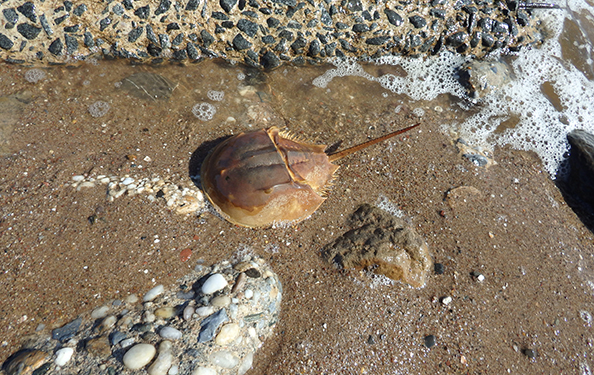
The Atlantic Horseshoe Crab is a species of arthropod that lives in coastal waters all along the eastward coast of North America. Every summer Horseshoe Crabs lay eggs on NYC'due south beaches, notably in Brooklyn's Coney Island Creek and at Staten Island'due south Conference House Park. Horseshoe crabs have existed as a species since before the dinosaurs evolved, millions of years ago.
Threats
Horseshoe crabs are threatened by habitat loss and overharvesting. They are harvested both for use as fishing allurement and past the pharmaceutical and medical industries, which utilize their claret to exam the sterility of drugs, vaccines, and equipment.
What we are doing to assistance
Together with volunteers, we monitor horseshoe crab spawning by counting and tagging individuals every May and June on beaches at Conference House Park, Kaiser Park, and Calvert Vaux Park. NYC Parks, with funding from NYS Dec, restored sandy beach habitat for horseshoe crab spawning at Calvert Vaux Park in 2013.
Learn more about horseshoe crabs in New York City parks
Piping Plovers
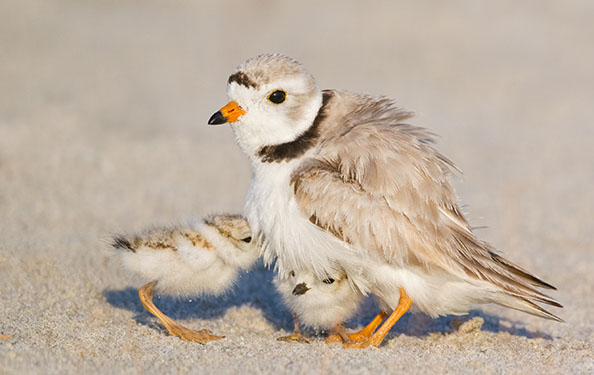
These pocket-size, lightly-colored shorebirds can be found on Rockaway Beach in Queens. Pipe plovers generally begin arriving in New York City in mid-March, some from as far south as South Carolina and the Bahama islands, to nest for the summer before migrating s in Baronial. They spend their wintertime months along the Gulf Coast and the southeastern seaboard of the United States.
Threat
Pipe plovers are considered an endangered species in New York Country, and are listed as threatened at the federal level. Hunting of pipage plovers for their feathers and for sport led to their near-extinction in the early 1900s. Although their populations were able to recover, they are yet at adventure. Their largest threats are predation, habitat damage and destruction, coastal development, and human disturbance. As of 2016, at that place were just 496 known breeding pairs in New York and New Jersey.
What nosotros're doing to assistance
Since 1996, NYC Parks has been managing the Rockaway Beach Endangered Species Nesting Area in Queens. This site is used by pipe plovers and other vulnerable shorebirds similar American oystercatchers, black skimmers, common terns, and least terns equally a nesting ground. Part of managing this site involves closing approximately ane mile of shoreline to the public to allow piping plovers and other threatened shorebirds to nest and incubate their eggs undisturbed. Parks' Wildlife Unit of measurement closely monitors their nesting sites for productivity and threats.
Learn more about pipage plovers in New York City parks
River Herring
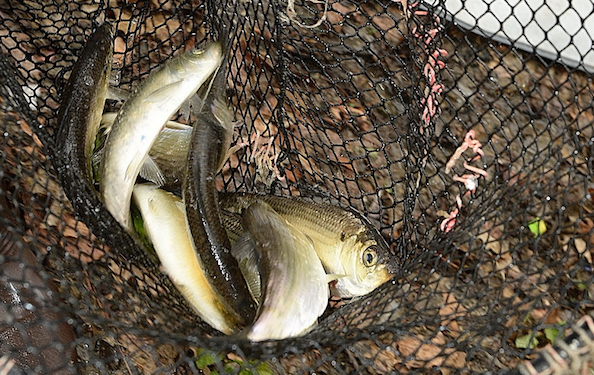
These fish visit NYC's freshwater rivers and streams with saltwater connections, most notably the Bronx River. In NYC, river herring can include ii different, but physically almost identical, species: Alewife and Blueback Herring. They spend the majority of their lives in saltwater only only come to freshwater to spawn. Every spring, river herring from the Atlantic Ocean swim upstream to freshwater to spawn, individuals returning to the same waters where they hatched multiple times in their lifetime.
Threats
River herring were once so abundant that their annual migration was recognized every bit the kickoff of spring. Populations accept declined dramatically due to overfishing and habitat loss caused by barriers like dams that forbid river herring from reaching their spawning habitat. Neither river herring species is considered threatened or endangered on a regional level, but due to local threats to their populations, NYS December considers them a high priority Species of Greatest Conservation Demand.
What we are doing to help
NYC Parks, in partnership with the Bronx River Alliance and others, is actively working to restore river herring populations in the Bronx River access to freshwater habitat. A fishway was installed at the start dam barrier in the River in 2015 to help river herring over the dam and access spawning habitat. Since information technology's opening, the fish ladder has immune more than 300 river herring to get over the dam. Parks likewise stocks the Bronx River with adult spawning Alewife each spring.
Other Notable Rare Wildlife
Parks also surveys and documents rare wildlife that apply NYC Parks properties as safety corridors to admission other areas in NYC, such as cemeteries, gardens, or state parks.
- The state-endangered mud turtle passes through City parkland in Staten Isle to admission Greenbelt waterways.
- NYC Parks researchers are also investigating sightings of the eastern worm snake (not seen in NYC for over 100 years) found in Emanu-El Cemetery in Queens, which is side by side to habitat in nearby Highland Park. This highlights how unexpected wildlife discoveries can however happen in large cities, and illustrates the demand to preserve and expand Forever Wild sites in New York Urban center.
If yous're interested in supporting efforts to protect these vulnerable species—or just appreciating some local wildlife—y'all can find wildlife-related events and volunteer opportunities on the City's WildlifeNYC website.
Source: https://www.nycgovparks.org/learn/wildlife-in-new-york-city/how-nyc-parks-protects-rare-and-at-risk-wildlife-species
Posted by: joneshany1989.blogspot.com

0 Response to "What Animals Have Been Endangered But Have Recovered In New York"
Post a Comment